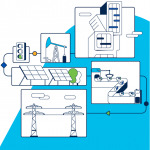Imagine deploying an internet of things (IoT) solution to track mobile assets, but there’s no internet access, no cellular connectivity and no power. The landscape is hilly with rocky outcrops, and, to make things even more interesting, you’re installing towers surrounded by wild lion prides and herds of buffalo. No sweat, right? But that’s nothing compared to the threats your assets face. Because the mobile assets you’re tracking? They’re rhinos.
Rhinoceros poaching is a severe problem in Africa. Each day, for the last five years, three African rhinos have been poached. Overall, two-thirds of the world’s five rhino species could be lost in our lifetime.
This is a shocking reality that Cisco’s Sustainable Impact program is working to change. As part of the Emerging Technologies and Incubation organization, this Tech for Good initiative combines engineering and innovation to solve some of the world’s most challenging problems.
Cisco is proud to be a part of a consortium of technology and conservation experts working with Ezemvelo KZN Wildlife to protect the world’s second largest wild rhino population in Hluhluwe-iMfolozi Park. We had the unique opportunity to partner with Peace Parks Foundation and NIL Data Communications to help deploy a Cisco networking solution, based on LoRaWAN™.
The LoRaWAN technology provides a unique geolocation solution for low-power, wide-area networks (LPWANs), enabling a wide range of applications requiring location determination for battery-powered devices. The Cisco Solution for LoRaWAN offers a fully integrated and functional infrastructure that includes a ruggedized gateway for LoRa radio access, a gateway IP management system, and a centralized controller for radio management of the gateways and end devices as well as geolocation management.
The Cisco LoRaWAN solution is typically deployed in urban environments. Given the unique constraints of the South African bush, we designed and developed a custom network for the park, which spans 960 square kilometers. It was an incredibly challenging — but equally rewarding — experience.
Before installing 25 towers across the park, we conducted advanced predictive RF simulation to determine the best locations for the LoRaWAN gateway. We needed an advanced RF design to cover the entire park and enable the best geolocalization. All of the equipment had to be ruggedized to protect it from animals and poachers and be completely autonomous of power. The solution also needed to be robust and reliable because the reserve doesn’t have the luxury of an IT staff. The system combines several technologies, including LoRaWAN, edge computing, Wi-Fi, cellular, point-to-multipoint RF link, solar panels, and batteries, and has become a generic multi-service platform that can be used in any park.
As a result of our efforts, the low-power, long-range technology can track sensors throughout the reserve, enabling rangers to locate rhinos and detect if poachers are present. The network is designed to be resilient and redundant with failover systems.
The integration of IoT and edge computing, with a smart Cisco network of tactically implemented sensors and systems, is changing the way in which critical natural resources and ecosystems are protected. But this is just the beginning — the rhino conservation project shows that you can bring the power of IoT to the most highly constrained environments, proving that there are no limits to what you can do with this technology.
To learn more about Cisco’s conservation work, and the Sustainable Impact program, check out our feature story, our first-look blog, and our symposium blog.

Great use of Cisco IoT technology and innovation!
This article is very insightful and provides a very successful IoT case study in challenging environment. Thanks. Could you please elaborate on how the solution is enabling rangers to detect if poachers are present?
Wow! That is the power of technology and IOT. Weldone Cisco